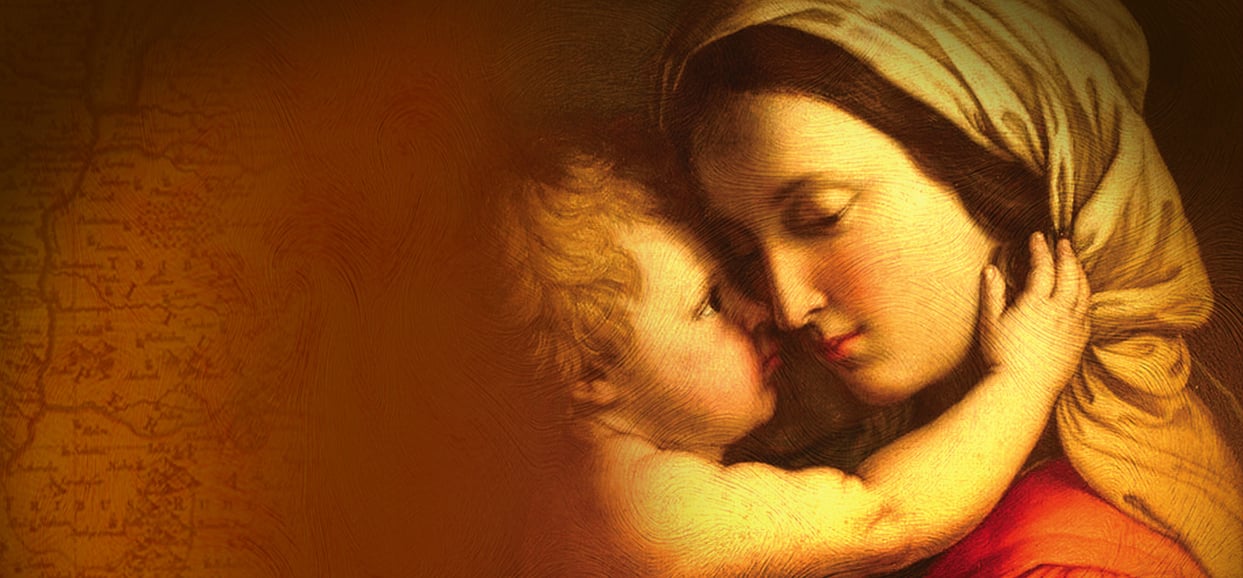Regina Caeli – Queen of Heaven, Rejoice!
The Regina Caeli, Latin for “Queen of Heaven,” is a hymn and prayer ...

Ambrose reflects on the Virgin Mary’s Visitation of her cousin Elizabeth as recounted by the evangelist Luke in the first chapter of his Gospel. The Visitation of the Blessed Virgin Mary is the second joyful mystery of the rosary. The Feast that commemorates this marvelous event is May 31.
T
hen the angel revealed his message to the Virgin Mary he gave her a sign to win her trust. He told her of the motherhood of an old and barren woman to show that God is able to do all that he wills.
When she hears this Mary sets out for the hill country. She does not disbelieve God’s word; she feels no uncertainty over the message or doubt about the sign. She goes eager in purpose, dutiful in conscience, hastening for joy. [Luke 1]
Filled with God, where would she hasten but to the heights? The Holy Spirit does not proceed by slow, laborious efforts. Quickly, too, the blessings of her coming and the Lord’s presence are made clear: as soon as Elizabeth heard Mary’s greeting the child leapt in her womb, and she was filled with the Holy Spirit.
Notice the contrast and the choice of words. Elizabeth is the first to hear Mary’s voice, but John is the first to be aware of grace. She hears with the ears of the body, but he leaps for joy at the meaning of the mystery. She is aware of Mary’s presence, but he is aware of the Lord’s: a woman aware of a woman’s presence, the forerunner aware of the pledge of our salvation. The women speak of the grace they have received while the children are active in secret, unfolding the mystery of love with the help of their mothers, who prophesy by the spirit of their sons.
The child leaps in the womb; the mother is filled with the Holy Spirit, but not before her son. Once the son has been filled with the Holy Spirit, he fills his mother with the same Spirit. John leaps for joy, and the spirit of Mary rejoices in her turn. When John leaps for joy Elizabeth is filled with the Holy Spirit, but we know that though Mary’s spirit rejoices, she does not need to be filled with the Holy Spirit. Her son, who is beyond our understanding, is active in his mother in a way beyond our understanding.
Elizabeth is filled with the Holy Spirit after conceiving John, while Mary is filled with the Holy Spirit before conceiving the Lord. Elizabeth says: Blessed are you because you have believed. [Lk 1:45].
You also are blessed because you have heard and believed. A soul that believes both conceives and brings forth the Word of God and acknowledges his works.
Let Mary’s soul be in each of you to proclaim the greatness of the Lord. Let her spirit be in each to rejoice in the Lord. Christ has only one mother in the flesh, but we all bring forth Christ in faith.
Every soul receives the Word of God if only it keeps chaste, remaining pure and free from sin, its modesty undefiled. The soul that succeeds in this proclaims the greatness of the Lord, just as Mary’s soul magnified the Lord and her spirit rejoiced in God her Savior.
In another place we read: Magnify the Lord with me. [Psalm 34:3].
The Lord is magnified, not because the human voice can add anything to God but because he is magnified within us. Christ is the image of God, and if the soul does what is right and holy, it magnifies that image of God, in whose likeness it was created and, in magnifying the image of God, the soul has a share in its greatness and is exalted.
For another post on the same subject by the Venerable Bede, read MARY’S VISITATION AND MAGNIFICAT
This meditation on the Visitation of the Blessed Virgin Mary of her cousin, Elizabeth, is an excerpt from St. Ambrose’s commentary on Luke (Lib. 2, 19.22-23. 26-27: CCL 14, 39-42), It appears in the Roman Office of Readings during the Fourth week of Advent, on December 21. It is also an excellent reflection for the Feast of the Visitation on May 31.
The featured image inset in the text is taken from the Basilica of the Visitation in Ein Karem, a village in the hill country of Judea where John the Baptist was born. The Basilica is built on the spot where the Visitation took place.
No Comments